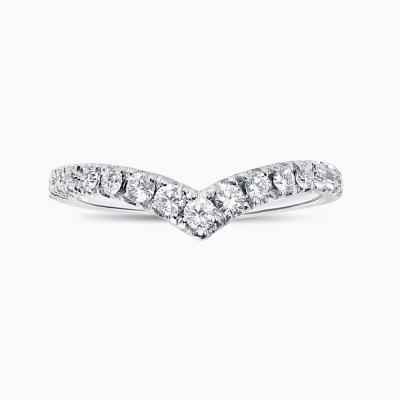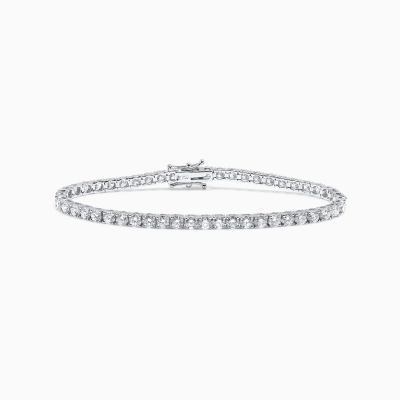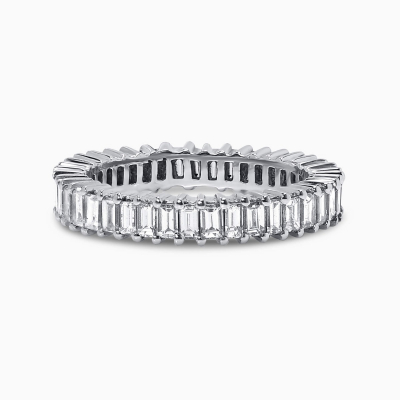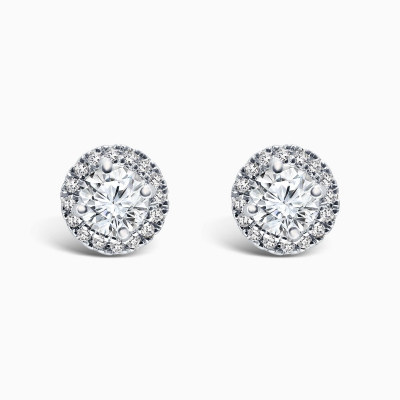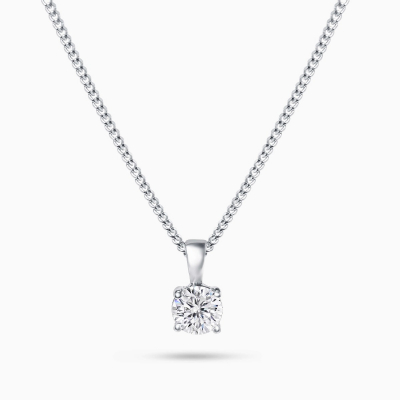USD
/
USD
/
Shipping to:
Currency:
PLATINUM
Platinum is perhaps the second most common metal used for engagement and wedding rings. It is always a popular alternative to yellow or white gold when it comes to special occasion jewelry. But how does it differ?
If you have your sights set on a white-colored metal, you generally have the option of platinum or white gold when buying an engagement or wedding ring. When combined with alloys and plated with rhodium, yellow gold can be transformed into white. The small issue with this is that the rhodium will wear off over time. While it is a simple job for a skilled jeweler to replace it, some people prefer platinum because this metal never loses its white look. Its natural color will not fade over time.
Although it is resistant to tarnishing or oxidizing, it is perhaps surprisingly more likely to scratch than, say, 14kt gold, which is mixed with a higher percentage of alloys. Nonetheless, like gold, platinum rings can be re-polished to look as good as new from time to time. Another advantage of platinum is that it develops a beautiful patina with age.
One of the disadvantages, perhaps, with platinum is that it is the more expensive metal of the two. This is because it is both around 30 times rarer than gold and also a denser metal. This, of course, adds to its strength and durability, but by the same token, more of it is needed to craft a ring. Its strength means that the claws, designed to grip the diamond in the ring, will do their job more readily than gold. Because it is denser, a platinum ring will also feel heavier than a gold one. Many people love the substance and weight, though again, it is a matter of personal choice.
One final reason to consider choosing platinum over gold is that gold mixed with alloys such as nickel can provoke an allergic reaction in a few people. Platinum is hypoallergenic, so if you are sensitive to alloys, this may be the better option.
Historical Use of Platinum in Jewelry: The story of platinum in jewelry-making is a testament to its enduring allure and value. Its journey from obscurity to prominence in the world of luxury is marked by key moments in history. Initially overlooked by early metalworkers due to its high melting point, platinum's unique properties eventually captured the attention of jewelers. By the 18th century, its rarity and luster made it a symbol of wealth and exclusivity. In the 19th and early 20th centuries, especially during the Edwardian era, platinum became the metal of choice for intricate and lavish jewelry designs, favored by royalty and the elite for its brilliant white sheen and strength. This period saw the creation of some of the most iconic and luxurious platinum jewelry, setting a standard for elegance and sophistication that continues today. Platinum's
Environmental Impact: While platinum's rarity and beauty make it a coveted material in the jewelry industry, its extraction and processing come with significant environmental implications. Platinum mining, primarily concentrated in South Africa and Russia, involves extensive extraction operations that have a considerable impact on the environment. The process requires large amounts of ore to be mined and processed to extract a small amount of platinum, leading to habitat destruction and significant energy consumption. Moreover, the refining process involves complex chemical procedures that can have harmful environmental effects. In response to these concerns, the industry is increasingly focusing on sustainable mining practices and the recycling of platinum, which not only reduces the demand for new mining but also minimizes the ecological footprint of platinum jewelry production.
Care and Maintenance Tips: Platinum, known for its exceptional durability and timeless appeal, requires specific care to maintain its pristine condition. Regular cleaning with a soft, lint-free cloth and a solution of mild soap and warm water can help preserve its luster. Unlike other precious metals, platinum is less prone to scratching, but it can still accumulate minor scuffs over time, which contribute to its distinctive patina. To restore its original shine, occasional professional polishing is recommended. It's also advisable to store platinum jewelry separately in a lined box or pouch to prevent scratches from contact with other pieces. Avoid exposing platinum to harsh chemicals, such as chlorine and cleaning agents, as they can cause damage. With proper care, platinum jewelry can retain its beauty and structural integrity for generations, making it a cherished heirloom.
Platinum vs. Other Precious Metals: Platinum stands out in the realm of precious metals due to its distinct properties and intrinsic value. Heavier and more durable than gold and silver, it offers a level of sturdiness unparalleled by other metals, making it an ideal choice for jewelry that withstands everyday wear. Its natural white color remains consistent over time, unlike white gold, which may yellow and require re-plating. This enduring color and sheen make platinum a preferred option for those seeking a metal that retains its appearance without the need for frequent maintenance. Additionally, platinum's rarity contributes to its higher price point compared to other metals, reflecting its status as a luxury choice in jewelry. Its hypoallergenic nature also makes it suitable for individuals with sensitive skin, further enhancing its appeal.
Customization and Design Flexibility: Platinum's unique characteristics make it a versatile and preferred medium for jewelry designers and artisans. Its exceptional malleability allows for intricate detailing and complex designs that are difficult to achieve with other metals. This flexibility enables jewelers to create bespoke pieces that cater to individual preferences, from elegant, minimalist designs to elaborate, ornate works of art. Platinum's strength ensures that gemstones are held securely in place, providing peace of mind for those wearing pieces with precious stones. Its resistance to wear and tarnish makes it an excellent choice for engagement rings and wedding bands that are meant to last a lifetime. The metal's natural white sheen enhances the brilliance of diamonds and other gemstones, making it a popular choice for high-end, custom-designed jewelry.







